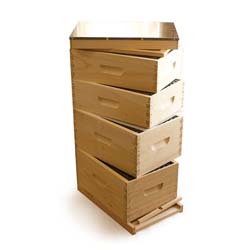Varroa mites can and do move between hives. They attach to their hosts (can be workers or drones), who bring them back into their hives through a few different methods. Most often they travel between hives due to drifting. Drifting is when a bee is trying to return to their home hive, but they slightly miss the mark and end up in another hive. This is a common occurrence, not something that should warrant concern. However, when a hive has a varroa mite problem, it can quickly turn into every hive’s problem.
Varroa mites feed on the bee’s hemolymph, draining them of energy and can cause them to become lethargic. Bees carrying varroa mites can drift into the wrong hives from exhaustion, acting as a carrier for the mite to infest this new colony. This ease of movement (using a natural occurrence in honeybees to spread to new hosts) is part of why they are such a prolific problem in recent decades.
It isn’t just accidental drift that can cause varroa mite movement. When colonies are weaker due to varroa mite infestation, they are often more vulnerable to being robbed by other honeybee colonies. When they’re being robbed, the mites will often hop onto the robbing foragers, traveling with them back to their original colony.
Varroa mites can easily move through swarming and absconding activity, moving with the swarming colony to spread their populations further. The more varroa mites in an area (even when they aren’t in your hives), the more susceptible your bees are to coming into contact with them.
Varroa mites can also move due to beekeeper intervention. When moving frames of brood between hives, you may inadvertently be moving varroa mites as well!
Varroa mite populations often increase in the fall. Less brood rearing means more phoretic mites available to feed on the bees themselves. Colder temperatures mean bees cluster closer together for warmth, allowing varroa to spread more easily inside a hive.
To help mitigate the spread of varroa between hives, many beekeepers try to keep their hives either:
1) Different colored boxes (painting them allows the bees visual distinction from each other)
2) Keeping hives at least three to six feet apart. Spacing can be tricky, especially with small bee yards.
3) Staggering hive placement. Instead of neat, straight lines of hives, move entrances to face different directions.
4) Place landmarks/visual cues around hives. Logs, rocks, anything that will give bees a visual landmark during their orientation flights will help.
5) Robbing screens. Robbing screens are usually used to help deter robbing but can also work to deter wandering foragers from coming into the wrong hive.
6) Checking for mites regularly and treating when necessary.
